

The value proposition of energy is in essence like this:
Expense is about the price per energy unit, for example dollars per Joule, and includes everything from the price of fuel, fuel systems, distribution, etc.
Supply Stability is about creating a stable supply of a given form of energy, for example electricity, heat, etc., and includes everything from reserves and re-creation time to place of origin including political conditions, transport, storage, etc.
Sustainability is about creating an energy supply that is in harmony with the environment in the broadest sense, including everything from climate impacts and pollution to working conditions, social conditions, etc.
Cumbers is about everything from waste, ash and security to construction, conversion, calibration, etc.
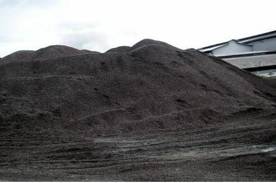
Mountain of shells. Thousands of tons in stock.
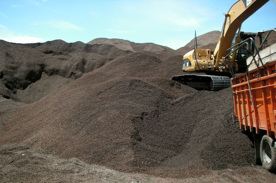
Loading of palm kernel shells. Palm shells is transported by truck to the port of discharge.
Palm kernel shells and coconut shells have high calorific values on par or better than other biofuels. This is partly due to the high concentration of carbon - approx. 46%. The gross calorific value is as high as 5,200 kWh/MT (18.80 GJ/MT) of palm kernel shells and 4,800 kWh/MT (17.18 GJ/MT) of coconut shells, while net calorific value is 4,900 kWh/MT (17.45 GJ/MT) for palm kernel shells and 4,400 kWh/MT (15.74 GJ/MT) of coconut shells - at a moisture content of 11.2 for palm kernel shells and 15.6 of coconut shells.
Net calorific value takes into account only the useful heat, ie. what is not lost through smoke and steam during the combustion. In a conventional boiler steam leaves the smoke system without utilization, whereas the condensing boiler also utilizes a portion of the energy of the steam by allowing it to condense, whereby the liquefaction heat is released. Gross calorific value takes into account the full energy - utilized or not. When burning pure carbon the net calorific value and gross calorific value will be identical, while the net and gross calorific value of mixed content will be different. The exact level of utilization will depend on the incinerator - with gross calorific value as upper (theoretical) limit.
Calorific value - both net and gross - is influenced by the content of water, ie. moisture by weight. The calorific value is directly proportional to the moisture percentage of the total weight as the water has no calorific value. When making comparisons to the quality of fuel, the fuel is dried to remove all moisture - to attain a neutral base line. Moisture ratio is affected by drying and storage.
The calorific value of palm shells is on par with the best wood pellets and far better than straw and wood chips. Only oil, coal and natural gas have better calorific value per tonne. In fact, the calorific value of palm shells is higher than pellets at a moisture content of 0, but due to the higher moisture content palm shells fall "down" on par with the best wood pellets.
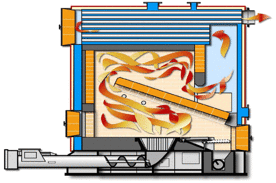
Section of stoker boiler. You can see how the stoker is fed from below.
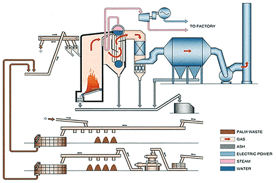
Power plant on biofuels. Electricity, heat and power plants can burn biofuel.
Because of the "natural" size and shape palm kernel shells will go straight in most stokers and other pellet boilers without modifications, even though it may be necessary to adjust the feed rate to reflect the calorific value.
Industrial fuel plants will usually inject pulverized fuel mixed with water - to achieve the best calorific value by exploiting røgkonvektorer. Therefore crushed palm shells, wood pellets, coal, etc. are a pre-processed, which makes industrial fuel system less sensitive to size and shape. However, it will in most cases be necessary to calibrate industrial fuel plants to run with new kinds of fuel, which is partly due to the burning temperature differs from fuel to fuel.
Palm shells is often successfully mixed with other fuels, for example coal and wood pellets, in both small and medium-sized stokers as in conventional heat and power plants. Especially stokers have proved very flexible in relation to mixed firing - both co-firing or and interval-firing - of coal and palm kernel shells without interruption - just with a bit of monitoring and adjustment of the combustion process. Large industrial plants can also benefit from co-firing with mixed fuel, but it typically requires a calibration process, which largely depend on the specific plant.
Compared to coal the amount of ash from palm shells is around fifth, especially coconut shells has a very low ash content of approx. 0.5%, while palm kernel shells contains a bit more with an ash content of approx. 3%. The ash from both palm kernel shells as coconut shells is safe without toxic metals.
Utilization depends on the incineration plant design, management and location. The utilization rate expresses how much of the heat that is channeled to useful purposes. When utilization is almost always less than 100%, because that incineration or distribution system gives off heat, which is not used. The utilization rate is the same no matter which fuel firing in a given fuel plants.
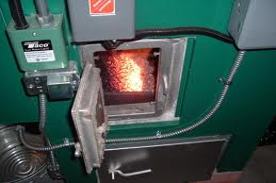
Stoker boiler. You can fuel most stoker boilers with palm kernel shells.
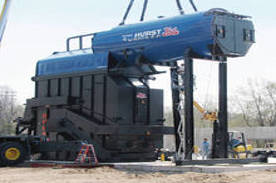
Mixed fueling. Stoker boiler designed for multi mixed fueling.
Oil palm and coconut trees grow in Africa, Asia and America. This means that the dependence on individual suppliers or specific countries or world-parts is limited.
Palmshells.com uses suppliers in several countries, but all of Africa. The choice of African countries as suppliers due to several factors, especially the relations of production are sustainable, and that the journey shorter and thus faster, cheaper and less polluting compared to imports from Asia or America, and partly to the calorific value of palm shells are higher and the ash content lower in Africa compared to Asia.
Palm plantations in Africa are predominantly small family-owned plantations, which in addition to sustainability provides the advantage that the supply of palm shells comes from a larger number of smaller suppliers, which constantly ensures competition and alternative supply options.
Supply stability is also about storage and reliable transport, which is almost exclusively a matter of price. Storage and punctual transport is absolutely possible to get. Palmshells.com goes into direct dialogue about the relationship between price on the one hand and storage and punctuality of transport on the other, and can offer a range of options in terms of storage and transport in terms of different degree of punctuality.
Palmshells.com only use suppliers who have undergone a comprehensive inspection of the business relationship and ability to deliver. In the energy sector, stability of supply is alpha-omega.

Loading and unloading. Here the shells are loaded and unloaded by grab.

Product Tanker. The shells are transported in containers or in product tankers as bulk.